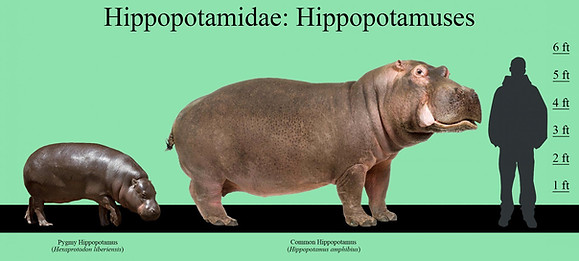Creature
Fast Facts
Introducing you to extinct species.

THE MALAGASY
DWARF HIPPOPOTAMUS
1. The Malagasy hippo, Hippopotamus lemerlei, was a dwarf hippo native to Madagascar. 2. The longest specimen was 6.5 feet long and 2.5 feet tall. 3. The Malagasy people of Madagascar had many names for this dwarf hippo including the mangarsahoc, tsy-aomby-aomby, the omby-rano, the laloumena, and the kilopilopitsofy. 4. Fossil evidence seems to indicate this hippo went extinct 1,000 years ago, but local stories and a recent skull found indicate this hippo survived until 200 years ago. 5. There may have been 3 different species of dwarf hippo in Madagascar. 6. At least 7 Malagasy dwarf hippo bones show signs of "butchery", meaning they were hunted and eaten by people. 7. Fossils have been found in forests indicating that this hippo was less aquatic than its larger relative. 8. The Malagasy pygmy hippo had eyes on the side of its head instead of high orbits like the common hippo. 9. Fossils indicate cursorial adaptations, meaning they were much better runners than the common hippo. 10. The villagers of Belo-sur-mer, Madagascar described an animal that visited their village in 1976 that matched the description of the Malagasy hippo and could even mimic a hippo noise although they had never seen or heard a common hippo.
Extinction
Cometh
Facing the light at the end of the tunnel
EXTINCTION DATE
1000's or 1976
The reason for the demise of the Malagasy dwarf hippo isn’t 100% clear. While there is evidence on at least 7 hippo bones of "butchery", overhunting doesn't seem to be the main reason. There have been times of drought in Madagascar which might have limited the water supply for this hippo. Although not much is known about this dwarf hippo, the fossils indicate it was adapted to a less aquatic lifestyle and was capable of running. Its extinction date is a topic of debate amongst scientists. Most fossils indicate the extinction date around 1,000 years ago after the arrival of people on Madagascar. Local stories of the Malagasy dwarf hippo have continued into modern times which would push the time frame to much more recently. In 1648, French governor, Étienne de Flacourt, heard reports of an animal that could only be a small hippo. In 1902, Raybaud, a colonial administrator named Raybaud, heard tales from locals that indicate the hippo survived until 1878. In the 1990's, Burney, a scientist researching extinct species of Madagascar heard tales from the Malagasy villagers of Belo-sur-mer of the 'kilopilopitsofy. They described that in 1976 the kilopilopitsofy had entered their village, was the size of a cow, was dark pigmented, grunted a lot, and when threatened, fled underwater." One man in the village was able to mimic a hippo noise from that experience even though he had never seen nor heard a common hippo before. These stories have caused the debate of its extinction. In 2020, a non fossilized pygmy hippo skull was discovered by Forrest Galante while taping an episode of Extinct or Alive for Animal Planet. That skull is believed to be less than 200 years old, giving credibility to these native tales. Could the Malagasy dwarf hippopotamus live in Madagascar today? Although Jurassic Park is fiction, scientists are working on several de-extinction projects. In fact, in 2003 scientists did bring back the extinct Pyrenean ibex, a type of wild goat, for 7 minutes before it died, showing de-extinction is possible. The Malagasy dwarf hippo might be a candidate. Scientists would potentially use DNA from the recent skull to bring them back to life. If the Malagasy dwarf hippopotamus was brought to life, could it ever be reintroduced to its native homeland in Madagascar? Madagascar is home to many unique animals today, most famously the lemurs and fossa. The biggest problem facing these animals is deforestation and forest fragmentation. In 2020, the Madagascar government launched a project to plant one million trees. The goal is to eventually plant 60 million new trees to connect the fragmented forests. Many projects like https://zahana.org/ are recruiting local people to raise and plant these trees. People who agree to plant trees and care for them are taught how to make better cook stoves which require less wood to use. The main use of trees in Madagascar is wood for cook stoves. Although Malagasy (people from Madagascar) value their unique wildlife and have many areas set aside as National Reserves, many animals are still taken from the wild and sold illegally. Madagascar ranks 10th in the world for poverty. In fact, 75 - 80% of the 26 million people there are living in poverty, making only $2 a day. The answers for how to protect endangered wildlife in Madagascar today are not simple. If the Malagasy dwarf hippo ever did make its way back to its native homeland, would it be able to survive?
COMING SOON
The little Malagasy dwarf hippo's Lazarus tale has yet to be written, but what adventures will await it when it returns to Madagascar? Stay tuned to find out.
More to Explore
All answers lead to more questions
Museum Skeleton
Image from Wikipedia
VIDEOS & ADDITIONAL INFO
Facts about the Malagasy Hippopotamus
Extinct or Alive - Dwarf Hippo - Video
2018 - Penelope the Endangered Dwarf Hippo Baby - Video

Museum specimen
Image from Wikipedia



Painting of extinct Madagascar dwarf hippo
Image from Prehistoric Fauna
A sketch of the Malagasy dwarf hippo.
Image from The Animals of Terrestrial Habitat

Hippo Size Comparison Chart
Image Zoo Chat

On an episode of Animal Planet's Extinct or Alive, Forrest Galante found a dwarf hippo skull that was less than 200 years old.
Image from YouTube

Prince Harry, the endangered pygmy hippo born in South Africa
Image from Zoo Borns

Endangered pygmy hippo facts
Image from Peppermint Narwhal

Glory the hippo from the Madagascar movies was a common hippo
Image from Wallpaper Cave



